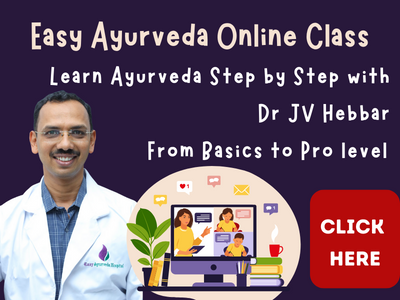Article by Dr Raghuram Y.S. MD (Ay) & Dr Manasa S, B.A.M.S
Dysautonomia is a fancy dysfunction affecting the Autonomic Nervous System (ANS). This method regulates physique capabilities like blood stress, coronary heart price, physique temperature and digestion. These processes can grow to be erratic and dysfunctional when one has dysautonomia. This may result in a wide selection of disruptive signs like chest ache, fainting, temper swings, fatigue and dizziness.
Associated Studying – Dysautonomia
Dysautonomia – Ayurveda Understanding
Nearly all capabilities of the autonomous nervous system are these of Vata and its subtypes. We all know that every one varieties of vata would have affect on one another, in states of steadiness in addition to imbalance. The signs pertaining to Dysautonomia are resulting from extreme imbalances of vata.
Initially the disturbance might begin on the degree of Prana Vata i.e. head, the seat of mind and central nervous system and in later phases of the illness, the opposite vata subtypes too will grow to be erratic, dysfunctional and imbalanced.
Although pitta and kapha might get entangled within the course of, most capabilities regulated by ANS appear as if being carried out by sane vata with serving to palms from the opposite doshas. Blood stress, coronary heart price, physique temperature and digestion – all these capabilities are carried out by vata.
Since secondary dysautonomia is brought on by autoimmune circumstances like GB Syndrome, Rheumatoid Arthritis, Sjogren’s Syndrome and SLE, we are able to think about the under talked about circumstances from Ayurveda perspective –
– Amavata
– Sandhigata vata
– Mamsagata vata
– Vatarakta
Even in these circumstances, vata is a significant part in pathogenesis.
In such circumstances, dysautonomia and its signs will probably be anubandha i.e. secondary to those pradhana vyadhis i.e. important illnesses. The road of remedy additionally will probably be in accordance with the talked about circumstances. For this, we have to set up a trigger and impact relationship between these autoimmune circumstances and dysautonomia.
Trendy drugs associates dysautonomia with neurodegenerative circumstances like Parkinsons’ Illness and A number of Sclerosis, that are additionally Vata predominant circumstances from Ayurveda perspective.
Likewise, metabolic issues that are causal of dysautonomia might be thought of as illnesses precipitated resulting from imbalance of samana vata.
Traumatic accidents that are the opposite essential trigger for Dysautonomia additionally aggravates vata and likewise rakta. They in flip may cause signs just like dysautonomia.
Lack of important vitamins within the weight loss plan is seen to trigger dysautonomia. Dietary deficiency can even trigger a rise in vata.
Likewise, Ayurveda additionally has described that extreme consumption of madya – alcohol would severely worsen all of the doshas, primarily vata. It could have a multi-system impression. Madya is alleged to be just like visha – poison. Trendy drugs has counted substance use issues amongst the causes of dysautonomia.
From the angle of varieties of Dysautonomia
Even after we see by means of the varieties of Dysautonomia, we get an enormous image of involvement of vata within the causation of those sorts. Instance – Postural Orthostatic Tachycardia Syndrome – POTS – presents with orthostatic intolerance resulting in speedy improve in coronary heart price – hrddrava and light-weight headedness – bhrama, that are signs of kapha lower. When kapha decreases, vata would clearly improve. They’re additionally the signs of vata improve.
Equally, the involvement of vata in different kinds of Dysautonomia shall be understood.
| Kind of Dysautonomia | Signs | Dosha concerned and associated circumstances |
| Orthostatic Hypotension | Low blood pressures on standing, resulting from change in positions | Vata Kshaya |
| Vasovagal syncope | Fainting resulting from stress or phobia | Vata
Murcha |
| Familial Dysautonomia | points with respiration, swallowing, and blood stress regulation | Vata – Prana, Udana and Vyana |
| Pure Autonomic Failure (PAF)
|
It’s a neurodegenerative dysfunction, characterised by orthostatic hypotension, sleep issues, and bladder points.
Could progress to Parkinson’s illness or different neurodegenerative circumstances. |
Vata –
Vyana, Apana, Prana. Kampavata. |
| A number of System Atrophy – MSA | Tremors, fainting, and coordination issues.
It normally develops in adults over 50 and progresses quickly. |
Vata
Kampavata Murcha |
| Inappropriate Sinus Tachycardia (IST) | Elevated resting coronary heart price, resulting in palpitations and dizziness. | Vata Vriddhi
Kapha Kshaya Bhrama |
| Autoimmune Autonomic Ganglionopathy (AAG) | Orthostatic hypotension, dry mouth, and urinary points. | Vata |
| Baroreflex Failure | Extreme blood stress fluctuations and coronary heart price adjustments in response to bodily or emotional stress, complications and unexplained sweating. | Vata Vriddhi,
Vyana Vata, |
| Hereditary Sensory and Autonomic Neuropathy (HSAN) | Altered ache notion and listening to issues.
|
Vata Vriddhi |
| Autonomic Dysreflexia | Life-threatening situation
Brought on resulting from overreaction of the autonomic nervous system, typically resulting from spinal wire accidents. Signs – hypertension, extreme complications, and visible disturbances. |
Vata Vriddhi
Vyana Vata Vataja Shirashula Rasagata Vata |
| Diabetic Autonomic Neuropathy
|
Impacts the cardiovascular, gastrointestinal, and urinary methods, inflicting problems like diarrhoea and erectile dysfunction. | Vata Vriddhi
Vataja Prameha / Madhhumeha
|
| Congenital Central Hypoventilation Syndrome (CCHS) | Shallow respiration,
developmental issues |
Vata Vriddhi
Pranavaha Sroto Dushti Shwasa Rasavaha Sroto Dushti |
| Paroxysmal Sympathetic Hyperactivity (PSH)
|
Attributable to traumatic mind harm,
Signs – elevated coronary heart price, blood stress, and physique temperature. |
Vata,
Vyana Vata Rasagata Vata |
| Postprandial Hypotension
|
This situation includes a drop in blood stress after consuming, resulting in dizziness and weak spot. | Vata Kshaya,
Annavrita Vata |
From the angle of signs of Dysautonomia
Wanting from the signs, perspective, once more we get an image of involvement of vata. It isn’t that the opposite doshas will not be concerned, they’re, however at a later stage. We are able to think about vata to provoke the illness course of and pita, kapha and rakta are concerned in later phases of the illness.
There are a lot of signs of dysautonomia. For the reason that autonomous system controls many methods and their capabilities within the physique, the signs comply with the system or methods concerned within the pathogenesis of the illness. They need to be thought of as under stated.
| System concerned in Dysautonomia | Essential Signs | Ayurveda perspective |
| Respiratory System | Respiration problem | Pranavaha Sroto Dushti (janya roga)
Shwasa, Kasa, Hrdroga |
| Cardiovascular System | Elevated coronary heart price, nervousness, palpitations or sluggish coronary heart price | Rasavaha / Pranavaha Sroto Dushti (janya roga), Rasapradoshaja Roga,
Hrdroga, Shwasa |
| Circulatory System | Issue standing nonetheless, dizziness after standing, erectile dysfunction, fainting, steadiness points, problem exercising, fatigue, pale pores and skin, vertigo, weak spot | Rasavaha / Pranavaha Sroto Dushti and Janya Rogas,
Prana, Vyana and Apana Vayu dushti |
| Excretory | Issue in defecation and urination, incontinence, dehydration | Purishavaha / Mutravaha Sroto Dushti & Janya Rogas
Apana Vata Vaigunya |
| Cognition / Central Nervous System | Forgetfulness
Issue in focusing Mind fog Migraine Insomnia Temper swings |
Manovaha Sroto Dushti / Janya Lakshanas
Prana Vayu and Udana Vata Vaigunya |
| Sensory system | Blurred imaginative and prescient
Sensitivity to gentle Sensitivity to sound |
Indriya Pradoshaja Roga |
Right here we are able to see that dysautonomia would have an effect on a number of methods and would produce associated signs. From an Ayurveda perspective, it’s Vata dushti / prakopa at varied ranges, methods and capabilities. Many srotas and mulas together with Pranavhaha, Rasavaha, Purishavaha, Mutravaha and Manovaha Srotas are affected and so are completely different subtypes of vata and their capabilities.
From the angle of problems of Dysautonomia
Problems associated to coronary heart together with abnormalities of coronary heart price like tachycardia, bradycardia, arrhythmia and many others resulting in further problems corresponding to chest ache, dizziness, coronary heart assault or stroke are resulting from hyperactivity of vata, primarily udana vata. It additionally displays the imbalance within the coordination with respect to the Prana-Udana-Vyana axis. Rasa and Pranavaha Srotas are troubled in these circumstances.
Recurrent fainting and respiration difficulties like shortness or breath, speedy respiration or problem in catching one’s breath resulting in circumstances like hypoxia which may additional trigger harm to important organs and tissues level in direction of comparable signs defined within the context of pranavaha sroto dushti – affliction of channels carrying air or life factor or harm to the identical. Prana Vayu and Udana Vayu are troubled in such pathology and so is Rasavaha srotas.
Equally, digestive problems arising on this situation like constipation, diarrhoea, gastroparesis are all brought on by vata imbalance – such signs may additionally be seen in shokaja or bhayaja atisara, udavarta, gulma and different circumstances brought on by vata.
Administration of Dysautonomia
Nidana Parivarjana
All vata aggravating causes together with meals, actions, behaviours and practices needs to be saved away. One ought to avoid stress and substance abuse.
Yukti Vyapashraya Chikitsa
Vata / Vata Vyadhi Chikitsa – As we have now seen that Dysautonomia presents with signs and patterns of ‘vata imbalance’ or ‘vata vyadhi’, it shall be handled as Vata Vyadhi. The road of remedy of vata vyadhi shall be adopted together with therapies, dietetic, life-style and behavioural corrections focussed in direction of balancing vata.
A sensible doctor also needs to look out for subtypes or subtypes of vata concerned within the pathogenesis and tackle the case accordingly. The systemic signs are clues to determine the vata subtype concerned within the illness.
Beneath talked about therapies are gamechangers within the remedy of Dysautonomia –
– Vasti
– Virechana
– Nasya
– Snehapana / Nitya Snehana
– Murdni Taila
– Abhyanga & Swedana
– Taila / ksheera / takra dhara – shiro, sarvanga
Herbs, medicines and formulations needs to be designed in accordance with the systemic signs and problems. Else medicines useful in combating vata will probably be helpful as an preliminary method.
Instance –
If respiratory signs are predominant in Dysautonomia, Shwasa Chikitsa or remedy for Pranavaha, Manovaha and Rasavaha Sroto Dushti could also be adopted. Measures to steadiness vata movement like Pranayama, meditation, destressing actions, and murdni taila procedures might be introduced into play. Formulations to strengthen the respiratory and circulatory system needs to be included. Medicines shall be in taila or ghrta base if vata signs are predominant.
If there are signs of the central nervous system or these pertaining to cognition, the Medhya dravyas – mind tonics shall be used. Ghrtas talked about within the context of Unmada and Apasmara like Brahmi Ghrta, Kalyanaka Ghrta, Paishachika Ghrta, Saraswatha Ghrta and many others needs to be used. Exterior therapies like Murdni Taila, Abhyanga and many others and Psychotherapy will probably be useful, together with observe of Pranayama, Yoga, meditation and many others. Daiva Vyapashraya Chikitsa too shall be resorted to.
Rasayanas needs to be introduced into the image as and when wanted.
Sattvavajaya and Daiva Vyapashraya Chikitsa
Psychiatric counselling and Psychotherapies needs to be included within the remedy of Dysautonomia. This may assist in complete thoughts therapeutic and also will deliver again to steadiness the imbalances occurring within the central nervous system and endocrine system. Dhee – mind-intellect coaching, Dhairya – psychotherapy, counselling and Atmadi Vijnana – realization therapies are the mainstays to heal the thoughts.
Divine therapies and perception therapies that are non-medicinal however extremely efficient shall be included within the remedy of Dysautonomia. They won’t solely assist in complete psychosomatic therapeutic however can even instill positiveness within the minds of the sufferers.
Different remedy rules to contemplate
In secondary Dysautonomia – Dysautonomia might be precipitated secondary to another illness or longstanding sickness. Therapy needs to be initiated for the pradhana vyadhi i.e. disease-causing signs of Dysautonomia. This would be the root remedy for the talked about situation.
The srotas concerned too needs to be recognized with the assistance of classical clarification of ‘sroto dushti lakshanas’. Therapy rules of the associated sroto dushti in accordance to the predominant signs manifested needs to be adopted.
Therapy needs to be finished on the rules of treating the under talked about circumstances if they’re causal for dysautonomia –
– Amavata
– Sandhigata vata
– Mamsagata vata
– Vatarakta
– Avarana
– Marmabhighata
– Panduroga
– Apatarpana janya rogas
– Murcha
– Kampavata
– Bhrama
– Unmada
– Apasmara
– Shirashula
– Rasagata vata
– Prameha
– Shwasa
– Hrdroga
– Udavarta
– Rasapradoshaja / Rasavaha Sroto Dushti Janya Roga
– Pranavaha Sroto Dushti Janya Roga
– Purishavaha / Mutravaha Sroto Dushti Janya Roga
– Manovaha Sroto Dushti Janya Roga and many others.


